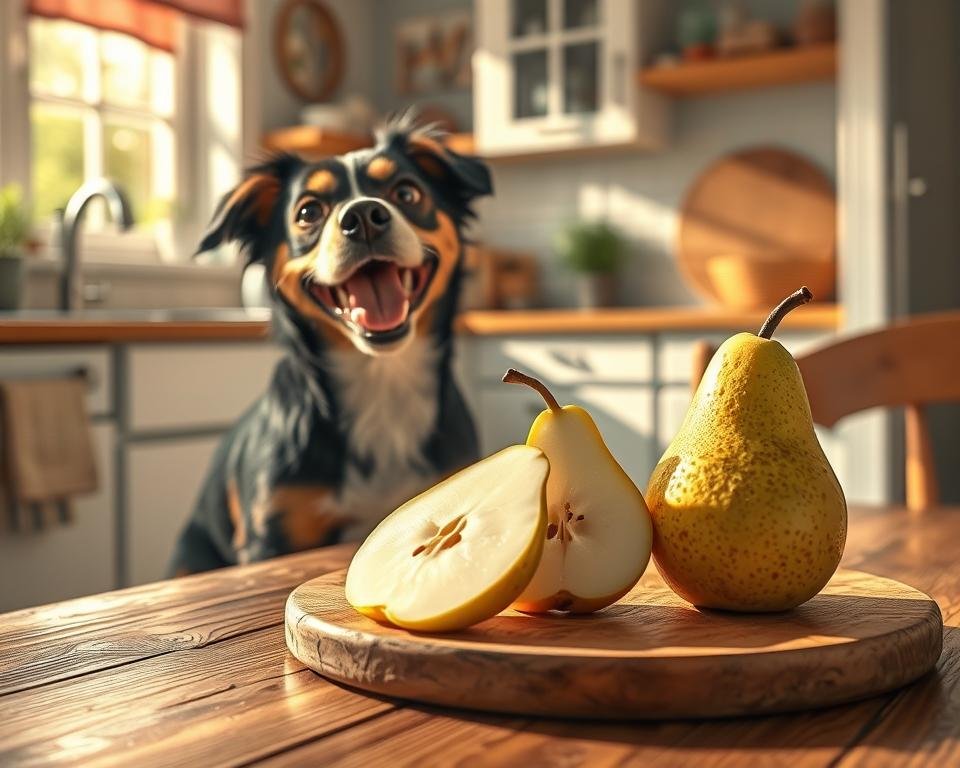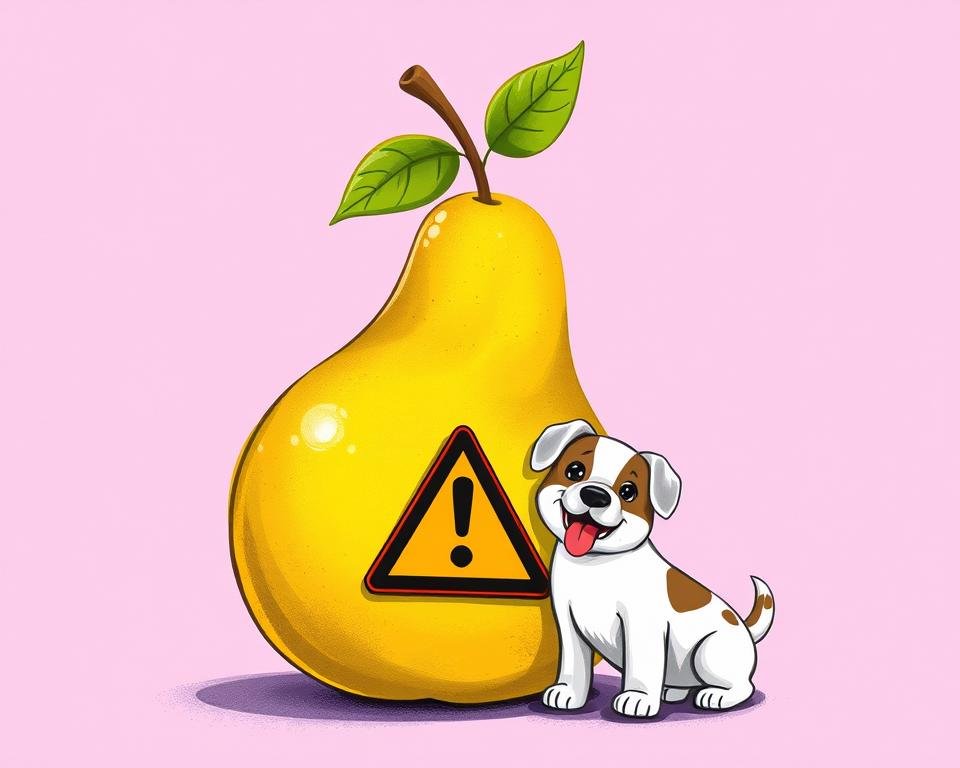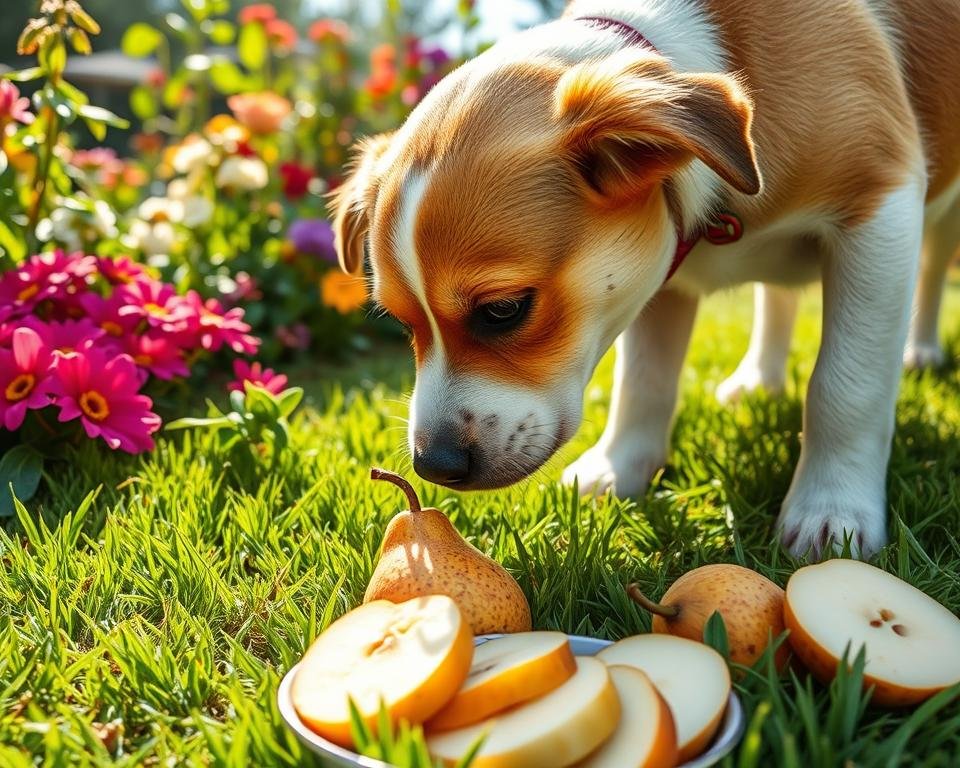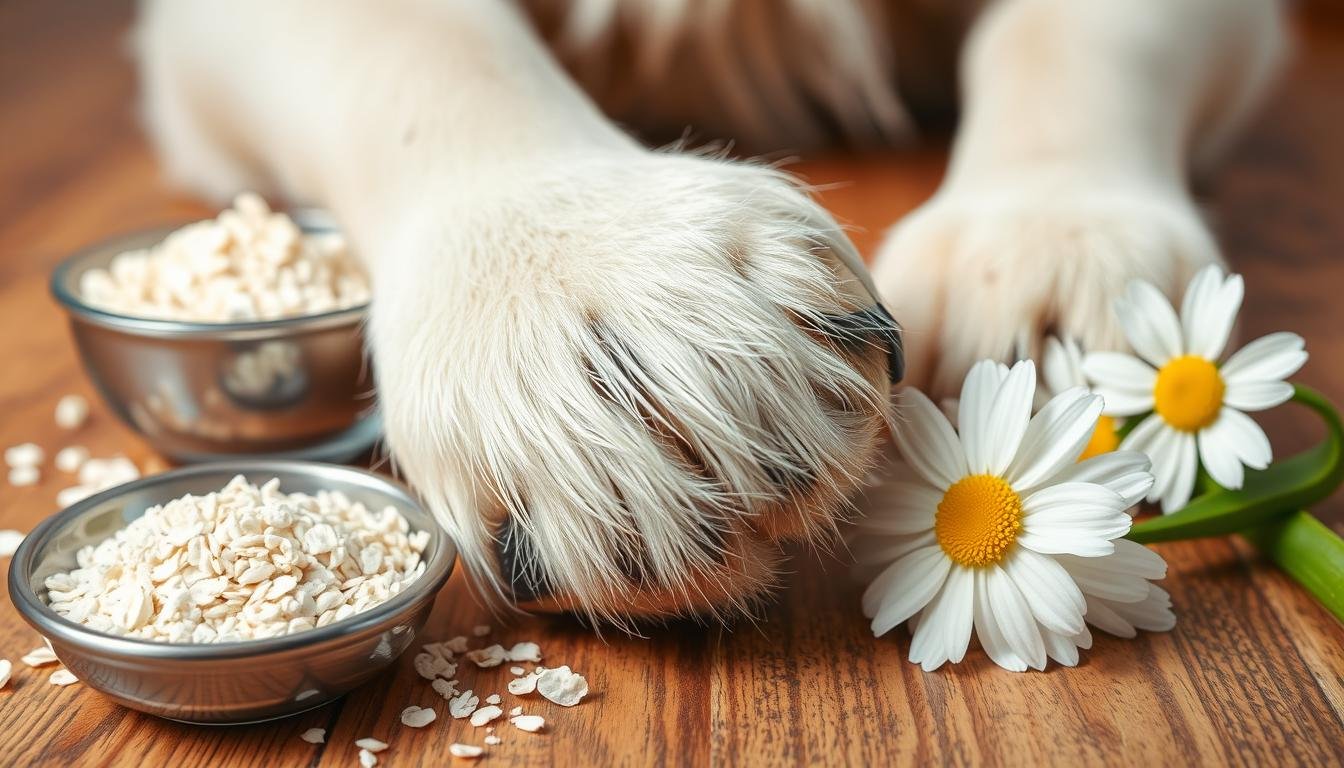Pears can be a safe and nutritious treat for dogs when given in small amounts. They are not a main part of a dog’s diet but offer many benefits. These include fiber, antioxidants, vitamins, and minerals.
But, it’s key to be careful about how you prepare and serve pears. This ensures your dog stays safe and healthy.
In this guide, we’ll look at the safety, benefits, and right amounts of pears for dogs. Knowing the right and wrong ways to give pears can help. This way, you can give your dog a tasty and possibly healthy fruit.
Understanding the Safety of Pears for Dogs
Pears are tasty and healthy for our dogs as an occasional treat. But, we must know the safety rules before giving them to our pets. Pears help keep dogs hydrated, support their digestive health, and provide important vitamins and minerals.
Nutritional Benefits at a Glance
Pears are low in calories and carbs, making them safe for dogs. They are packed with nutrients like:
- Vitamin C, which boosts the immune system
- Vitamin A, good for eyes and skin
- Vitamin K, important for blood clotting
- Dietary fiber, helps with digestion
- Antioxidants, fight off harmful free radicals
Safety Considerations for Pet Owners
While pears are beneficial, we must be careful. Pear seeds, stems, and leaves have cyanide, which is toxic to dogs. Always remove these parts before giving pears to your dog.
Also, cut pears into small pieces to avoid choking. Eating too many pears can upset their stomach, causing vomiting and diarrhea. So, limit pear treats to 10% of their daily calories. Always talk to your vet before adding new foods to your dog’s diet.

“Pears are a great source of hydration and fiber for dogs, but it’s vital to follow safety guidelines to ensure their well-being.”
Can Dogs Eat Pears: Essential Guidelines
Feeding pears to your dog needs careful attention to keep them safe and healthy. Pears can be a healthy, occasional treat if introduced and eaten right.
Start by giving fresh, ripe pears in small amounts. Avoid canned pears because they have too much sugar, which is bad for dogs. Pears are full of vitamins C and K, and fiber, making them a good snack for dogs in the right amounts.
- Take off the stem, leaves, core, and seeds before giving pears to your dog. These can choke them or have toxins that are bad for dogs.
- Cut the pear into small pieces to avoid choking and help your dog digest it better.
- Slowly add pears to your dog’s diet to avoid any stomach problems or bad reactions.
- Don’t give your dog more than 10% of their daily calories in pears. Pears should be a treat, not a food to replace their regular dog food.
By following these guidelines, you can safely give pears to dogs as an occasional treat. This ensures your dog stays healthy and happy. Always talk to your vet if you’re unsure about your dog’s diet or new foods.

Health Benefits of Pears for Your Canine
Pears are tasty for humans and good for dogs too. They are a healthy snack for your dog when given in small amounts.
Vitamins and Minerals in Pears
Pears are packed with vitamins and minerals that help your dog stay healthy. They have vitamin C to boost the immune system and vitamin K for strong bones. They also have copper, folate, and potassium, all key for your dog’s health.
Fiber Content and Digestive Health
Pears are high in fiber, which is great for your dog’s digestive system. Fiber helps prevent constipation. Spot’s data shows that dietary issues cost $642 on average, so fiber is vital.
Antioxidant Properties
Pears have antioxidants like anthocyanins, lutein, and zeaxanthin. These help keep your dog healthy by fighting off free radicals and reducing disease risks, including heart problems.
Remember, pears should be given in small amounts. Treats, including pears, should not make up more than 10% of your dog’s daily calories. This prevents obesity and dental issues. Always introduce new foods slowly and watch for any bad reactions.

Be careful with human foods that are bad for dogs. Avoid chocolate, grapes, raisins, onions, garlic, avocados, and alcohol. These can be very harmful or even deadly.
By giving pears in moderation, you can help your dog’s health. This dog-friendly fruit supports your pup’s overall well-being.
Potential Risks and Dangers
Pears can be a healthy snack for dogs, but there are risks to be aware of. Pear risks for dogs include choking hazards from large pieces or seeds. They can also cause stomach upset if eaten too much.
The seeds, stems, and leaves of pears have cyanide, which is harmful in large amounts. It’s important to remove the core and seeds before giving pears to your dog. Canned pears, with their high sugar content, can lead to obesity and tooth decay in dogs.
Vets suggest dog diet precautions when adding new foods like pears. Start with small amounts and watch for any signs of trouble. If you’re unsure about adding pears to your dog’s diet, talk to your vet.
| Potential Risk | Explanation |
|---|---|
| Choking Hazard | Large pieces of pear or the seeds can pose a choking risk, even for small dogs. |
| Gastrointestinal Upset | Eating too many pears can cause vomiting, diarrhea, and other stomach problems. |
| Cyanide Toxicity | The seeds, stems, and leaves of pears contain cyanide, which is dangerous in large amounts. |
| Obesity and Tooth Decay | Canned pears are too sugary and not good for a dog’s diet. |
Knowing the pear risks for dogs helps pet owners keep their dogs safe and healthy. This way, dogs can enjoy pears without harm.

Safe Portions and Serving Sizes
Feeding pears to your dog needs careful attention to portion size. The right amount depends on your dog’s size and weight. Knowing the right serving sizes helps your dog enjoy pears’ health benefits without stomach problems.
Small Dog Portions
For dogs weighing 2 to 20 pounds, 1-2 small pear pieces are safe. Dogs weighing 21 to 30 pounds can have 2-3 slightly bigger pieces.
Large Dog Portions
Dogs weighing 31 to 50 pounds can have 5-6 pear pieces. Larger dogs, from 51 to 90 pounds, can have a small handful. Extra-large dogs over 91 pounds can have a full handful as an occasional treat.
Remember, pears should not be more than 10% of your dog’s daily calories. Always cut pears into safe sizes to avoid choking. Watch how your dog reacts to make sure they can handle the fruit.
By following these guidelines, you can add pears to your dog’s diet as a healthy snack. This way, you keep your dog’s health in mind while enjoying the treat.
How to Prepare Pears for Your Dog
Feeding pears to your dog needs careful preparation. Pears are safe and healthy for dogs, but you must take steps to keep them safe and tasty.
Start by washing the pears well to get rid of any bad stuff. Then, take out the stem, leaves, core, and seeds. These parts have cyanide, which is bad for dogs.
After that, cut the pear into small pieces that fit your dog’s size. You can leave the skin on if it’s clean. For a fun treat, mash the pears or blend them with other safe fruits for a homemade snack.
For a cool treat, try freezing the pear pieces. You can also mix them with plain, sugar-free yogurt for a creamy snack.
Always start with small amounts and watch how your dog reacts. If they seem uncomfortable, stop and talk to your vet.
“Pears are a great source of vitamins, fiber, and antioxidants that can benefit a dog’s overall health.”
By following these easy steps, you can make pears a tasty and healthy treat for your dog.
Parts of the Pear to Avoid
Feeding pears to dogs requires careful attention to certain parts that can be harmful. The dog food safety and toxic foods for dogs are key for pet owners. They aim to give a safe and healthy diet.
Seeds and Core Hazards
Pear seeds have a small amount of cyanide, which is toxic to dogs. The core can also cause intestinal blockages because it’s hard to digest. Always remove the seeds and core before giving pears to your dog.
Stem and Leaves Concerns
The stem and leaves of pears also have cyanide and should be removed. Eating these parts can harm your dog’s health. It can cause digestive problems and other issues.
Knowing which parts of the pear are dangerous helps pet owners safely give pears to their dogs. Removing the seeds, core, stem, and leaves is important. It ensures your dog stays healthy and safe from toxic foods.
| Part of Pear | Potential Hazard |
|---|---|
| Seeds | Contain trace amounts of cyanide, can be toxic in large quantities |
| Core | Difficult for dogs to digest, can cause intestinal blockage |
| Stem and Leaves | Also contain cyanide, can lead to digestive issues and other complications |
“Feeding dogs canned or candied pears should be avoided due to their high sugar content.”
By focusing on dog food safety and knowing which foods are toxic, pet owners can give pears safely. This knowledge helps keep your dog healthy and happy.
Fresh vs. Canned Pears: What’s Best for Dogs
When it comes to healthy dog snacks, fresh pears are the top choice. They are full of fiber, vitamins, and minerals that are good for your dog’s health. On the other hand, canned pears are not as good for dogs.
Canned pears are filled with sugar and preservatives. This can cause weight gain, dental problems, and upset stomachs in dogs. They also lack the natural fiber found in fresh pears.
For a healthy treat, choose fresh, ripe pears for your dog. They are sweet and full of fiber, which is great for your dog’s health. Just make sure to remove the seeds and core to avoid choking hazards and cyanide poisoning. With the right preparation, fresh pears can be a tasty and healthy treat for your dog.



